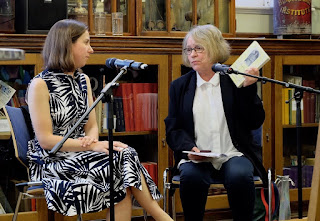Just days before she left for America for the first time, Sylvia
Pankhurst was hit by a devastating tragedy. Today, I set out with my partner Morgan
Daniels, like me a historian who likes to walk through the past, to retrace the
story – and made an important rediscovery of suffragette history.
Sylvia Pankhurst did not join her family for Christmas in
1910, instead she spent the day alone trying to finish her book The Suffragette ahead of her tour of
America. Her mother, suffragette leader
Emmeline Pankhurst, was spending Christmas at the home of her brother, Herbert
Brownridge Goulden. Brownridge was their
grandmother’s maiden name – Mary Goulden née Brownridge had been a member
of the Anti-Corn Law League and Sylvia later recalled that young Emmeline had been
enraptured by her stories of the “Hungry Forties”.
Herbert Goulden was a longstanding support for the Pankhurst
family. He had moved into their home in
Nelson Street (now the Pankhurst Centre) after Emmeline’s husband Richard
Pankhurst died to help share expenses. At
Christmas 1910 we find him at his home, 6 Radcliffe Road, Winchmore Hill in
Southgate, having dinner with his sisters Emmeline Pankhurst and Mary Jane
Clarke.
Sylvia adored her aunt Mary and both were artistic.
It seems that Mary escaped an unhappy marriage
and became involved in the suffragette movement – she was an organiser for the
WSPU in Brighton.
By Christmas 1910,
Mary had just been released from prison after being convicted for throwing stones
in protest at the police brutality meted out to suffragette protesters on what
became known as
‘Black Friday’.
At some point on Christmas Day, Mary left the dinner table
and was found unconscious by Emmeline.
She had died of a burst blood vessel on the brain; her family believed
that this had been caused by her recent imprisonment.
Today we followed the route from Radcliffe Road to Southgate
cemetery where she was buried. Much of
the area is now a very prosperous North London suburb with enormous detached
houses with multiple expensive cars parked outside. Stories of inequality, of people facing
starvation had impassioned the young Emmeline Pankhurst. Today inequality is on the rise again and increasing
numbers of people – many of them in work – are going to food banks.
We did not know exactly where Mary Clarke was buried, and I
believe that no one has known for a long time now. There were a few queries about it on Twitter
but no answers. Morgan and I endeavoured
to find out – by looking at every grave.
It was a daunting task, many of the graves are completely covered with
ivy, some of the gravestones have fallen face down, others are illegible. If Mary Clarke’s grave had been forgotten,
wasn’t it likely that one of these might be her anonymous resting place? And then I saw her name. Her grave is not far into the cemetery: it is
in the second section on the right as you enter from Waterfall Road and it
faces the path. It is on the crest of a
hill overlooking North London.
Beneath a Celtic cross (like her sister Emmeline’s
grave this is probably in reference to their mother’s Manx heritage) is inscribed “Mary J.
Clarke died December 25th 1910”.
And then these words from the Gospel of St John: “Greater love hath no
man than this that a man lay down his life for his friends”.
 |
| The grave of suffragette Mary Jane Clarke, sister of Emmeline Pankhurst |
Two and a half years after the death of Mary Clarke, the
suffragette Emily Wilding Davison stepped out in front of the king’s horse
during the Epsom Derby race, was knocked down and killed. She was carrying the suffragette
colours. Emily Wilding Davison, and not
Mary Clarke, would be commemorated as the suffragette martyr. And yet, the front page of The Suffragette and the funeral service would
carry the same words etched onto Mary Clarke’s grave. They are words that pay tribute to the
sacrifice that so many suffragettes were prepared to make in their activism. This is one reason why the rediscovery of
this grave is so important. It tells the
story of what women sacrificed to win their political rights.
 |
| Commemoration of Emily Wilding Davison using the same words from the Gospel of St. John as on Mary Clarke's grave |
Sylvia Pankhurst was told about her aunt’s death by her
mother on Boxing Day. The hugely painful
and personal cost of this struggle was on her mind as she travelled to America
to explain to audiences why women were militant.
And what of Herbert Goulden?
Walk to nearby Palmers Green and you will find at the Triangle on Green
Lanes a tribute to his part in the suffragette struggle.
A plaque marks the place where, at a
suffragette meeting, he was recognised as Emmeline Pankhurst’s brother and
attacked by a mob.
You can read about this
incident and his contribution to the suffragette movement in a post by the late
Ruby Galili.
 |
| The plaque in Palmers Green paying tribute to Herbert Goulden. |
Herbert Goulden is buried alongside his two children in the
same grave as his sister Mary Clarke.

























